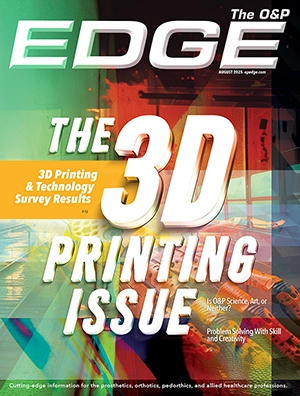
Thermal images of the foot before (A) and after cooling (B). Note the temperature contrast between the cooled (right) foot and uncooled foot (left) in B. Average temperature of the right foot remained in the vicinity of 28 C, which was shown to preserver the tissue against breaking down. TAPMARI in use (C).
Photograph courtesy of Metin Yavuz.
Scientists at UT Southwestern Medical Center developed cooling insoles to reduce foot temperature, diminishing the risk of tissue breakdown that contributes to amputations in people with diabetes. People with diabetic foot ulcers have a mortality rate of 50 percent within five years.
“Even when patients receive therapeutic shoes and insoles, education, and close monitoring, 30 to 40 percent of patients who have had one diabetic foot ulcer will still develop another within a year,” said Metin Yavuz, D.Eng., an associate professor in the School of Health Professions’ Division of Prosthetics and Orthotics at UT Southwestern Medical Center who led the study.
Animal studies have shown that skin maintained between 25 and 30 degrees C is less likely to break down under pressure than skin at higher temperatures. The feet of patients with diabetes already tend to be warmer due to inflammation associated with the disease, Yavuz said, compounded by friction from walking and the stiff therapeutic shoes that patients wear, which are usually made of synthetic materials that act as heat insulators.
Yavuz and his lab, aided by a pilot grant from UTSW’s Center for Translational Medicine, developed a system that circulates cool water into pressure-relieving insoles. The device, which the researchers named Temperature and Pressure Monitoring and Regulating Insoles (TAPMARI), consists of a small box strapped to the wearer’s calf that houses a cooling unit, a small water pump, a battery pack, and a thermostat. The cooling unit harnesses a type of thermoelectric cooling called the Peltier effect to chill water to a desired temperature that is then pumped into insoles in the wearer’s shoes. Yavuz later teamed up with an engineering company and obtained funding from the National Institutes of Health to improve the design.
The researchers tested the device in eight volunteers: one man and seven women of a median age of 45 years. Five of the volunteers were healthy and three had diabetic neuropathy.
Using an infrared thermal camera, the researchers took photos of the subjects’ feet at baseline before wearing the insoles, then placed a cooling insole in only their right shoes. They took more thermal photos after the subjects walked five minutes on a treadmill and again after they wore the insoles an additional two hours and walked five minutes on the treadmill again.
Results showed that the mean baseline foot temperature in the group was 28.1 degrees C. Mean foot temperatures at the end of the study were 31.7 degrees C for the left foot and 25.9 degrees C for the right, which was cooled by TAPMARI. Although the feet of the participants with diabetes got warmer than those of the healthy volunteers during walking, they still maintained a mean temperature of 27.5 degrees C in the right foot, suggesting that the insoles could maintain temperature in a range that protects against skin breakdown.
Cool temperatures from the insoles didn’t cause vasoconstriction (narrowing of blood vessels) in the foot, which could have damaged tissue, Yavuz says. However, sole temperatures reached as high as 30.8 degrees C in some regions of the cooled feet, particularly in the midfoot, suggesting that the design of the insole needs to be improved.
The study, Temperature- and Pressure-Regulating Insoles for Prevention of Diabetic Foot Ulcers, was published in The Journal of Foot & Ankle Surgery.
This story was adapted from materials provided by UT Southwestern.



